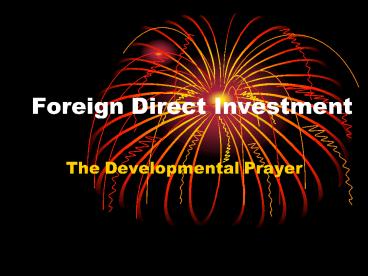Foreign Direct Investment - PowerPoint PPT Presentation
1 / 17
Title:
Foreign Direct Investment
Description:
Countries sell bonds to private citizens (1918-1939, some popularity after 1990) Bank finance. ... World Bank or Inter-American Development Bank. Federal ... – PowerPoint PPT presentation
Number of Views:46
Avg rating:3.0/5.0
Title: Foreign Direct Investment
1
Foreign Direct Investment
- The Developmental Prayer
2
How is development achieved?
- The key to economic growth is
- Investment!
- Where does it come from?
- Savings
- Retained earnings
- Gifts
- Investments
3
Who is interested in anLDCs economic growth?
- Who is interested enough to pay
- for such growth?
- The Multis
- What are the multis interests?
- Low labor costs
- Profits
- Avoiding a bad reputation
4
What are the potential benefits of foreign
investments?
- Growth of capital stock
- Incorporated technologies
- Possibilities to gain managerial and labor skills
- Higher incomes and economic development.
(Taxation for public sector) - Finance education
- Finance health
- Finance infrastructure development, etc.
5
What are the potential costs of foreign
investments?
- Dependence on external powers?
- Sweatshops and (child?) labor exploitation.
Working conditions and wages.
6
What are the potential costs of foreign
investments?
- Environmental degradation
7
Can the costs be avoided?
What do the LDCs want?
- Dependence on external powers?
- Dependence may be better than continual,
grinding poverty. - Sweatshops and (child?) labor exploitation.
Working conditions and wages. - The LDCs want low costs, too. Why?
- Environmental degradation
- The LDCs are less concerned about this than we
are. Why? - How can the appropriate outcomes be achieved?
8
Capital Inflow Types
- Bond finance.
- Countries sell bonds to private citizens
(1918-1939, some popularity after 1990) - Bank finance.
- (1970s and 80s) LDCs borrowed extensively from
commercial banks. - Official Lending
- Loans from the World Bank or Inter-American
Development Bank
Federal Reserve Bank
New York Stock Exchange
9
Capital Inflow Types
- Direct Foreign Investment
- A firm mostly owned by foreign residents founds
a subsidiary firm domestically. - Portfolio investment in ownership of firms
- Purchasing shares of stock in LDCs (often
privatized) firms.
10
FDI or Portfolio Investments. Which way is the
better?
- FDI is done by the multinational firms to
maintain control, to keep costs down. - Why do we have firms?
Hong Kong
11
FDI or Portfolio Investments. Which way is the
better?
- Administrative costs (Here, were speaking of
the firms costs of contracting, coordination,
motivation, information provision, etc.) - If high, go to the market.
- (The old question make or buy?)
12
FDI or Portfolio Investments. Which way is the
better?
- Transactions costs
- If the firm doesnt make it, it must find it,
negotiate about a price, contract, motivate the
contract, enforce the contract, etc.) - If these costs are high, go to production by
the firm.
13
FDI or Portfolio Investments. Which way is the
better?
- Benefits.
- These can be shared with the LDC
- Ban them?
- Regulate them?
- Domestically and through
- international agencies?
- Promoting competition may be best
14
FDI or Portfolio Investments. Which way is the
better?
- Portfolio capital comes without the multis
demanding control. - But it comes without technology and the
- transfusion of skills.
- And it can disappear quickly!
15
FDI or Portfolio Investments. Which way is the
better?
- The problem of financial crises, such as the
Asian Crisis beginning in 1997. - Insufficient returns on investments
flight,
Singapore
16
FDI or Portfolio Investments. Which way is the
better?
- Stock prices collapse
- Withdrawals exchanged for
- Crash of local currency value
- Imports now very expensive
- Severe recession
17
So the disadvantage of FDI is managing multis
- Is this possible for LDCs?
- If not, does it matter?
- Why?
- There are still international agencies and
- International public opinion
- Times are changing.
- If not fast enough, will the LDCs try going it
alone? - Certainly not! FDI benefitscosts.































